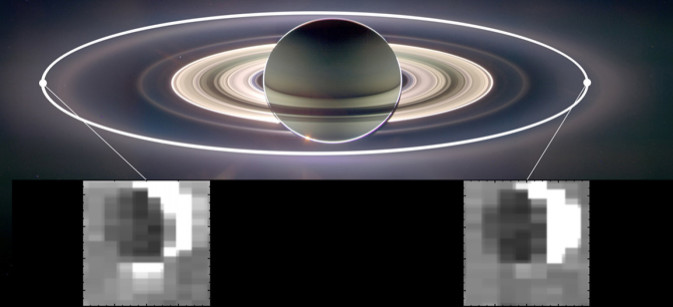Saturn Squeezes Moon Enceladus, Squirting Jets Of Ice From 'Tiger Stripes' At South Pole

Enceladus, one of Saturn’s dozens of confirmed moons, is one of the few ice-covered worlds in our solar system. The moon sprays jets of ice from four vast cracks, dubbed “tiger stripes,” on its south pole. Some of the ice falls back on Enceladus as snowfall, while some of it contributes to Saturn’s rings. But the flow of ice from these jets is not constant, and researchers have wondered what drives the variable spew of Enceladus for some time.
Now, scientists led by Cornell University researcher Matt Hedman think they’ve hit upon the solution: Saturn’s gravity squeezes Enceladus with a predictable rhythm throughout the moon’s orbit, sometimes allowing more material to escape. They reported their findings in the journal Nature Wednesday.
The secret is similar to the principle behind tidal forces on Earth. The pull that a planet or star exerts on its satellites is not constant. At any point in a moon’s orbit around a planet (or a planet’s orbit around a star), the near side of the satellite is pulled slightly more by gravity than the far side.
Depending on where Enceladus is at in its orbit, Saturn’s gravity “can either stretch or squash the moon,” Hedman said in a phone interview Friday. And that stretching and squashing morphs the so-called tiger stripes that emit the jets of ice, he said: “[Saturn] can basically force shut or pull open those cracks.”
Hedman and his colleagues arrived at the find by looking at infrared data of Enceladus’ emissions taken by NASA’s Cassini spacecraft. They noticed that the brightness of the plumes at the point of Enceladus’ orbit farthest from Saturn was about three times greater than the brightness when the moon was closest to the ringed planet.
There are still probably some other random factors that contribute to the variable nature of the ice jets, Hedman said. There may be points at which a large glut of ice particles first plugs up part of a tiger stripe and then eventually spews forth.
The behavior of Enceladus’ jets in response to tidal forces may also hold a clue to the moon’s internal structure. Scientists have long thought that Enceladus might have liquid water underneath its icy crust, but there’s no definitive proof yet. The possibility of water on Enceladus is extremely exciting for exobiology enthusiasts.
“The way the jets react so responsively to changing stresses on Enceladus suggests they have their origins in a large body of liquid water,” co-author Christophe Sotin, a Cassini team member at NASA’s Jet Propulsion Laboratory, said in a statement. “Liquid water was key to the development of life on Earth, so these discoveries whet the appetite to know whether life exists everywhere water is present.”
Other scientists may want to build on this latest find by comparing the tidal-force model with one or more other models of activity in Enceladus’ interior, to see whether they match up, according to Hedman. His team’s next step will most likely be to take an even closer look at the ice plumes escaping from the tiger stripes. Instead of just watching for varying brightness of the ice plumes, as they did with this study, they would like to use a spectrometer to look at the colors of light reflecting off the plume, which may give some insight into the size of the ice particles being spewed out from the moon’s interior.
“We’ll use the same data set as this paper, but pour more into it,” Hedman said.
Source: Hedman et al. “An observed correlation between plume activity and tidal stresses on Enceladus.” Nature, published online 31 July 2013.
© Copyright IBTimes 2024. All rights reserved.





















